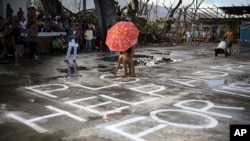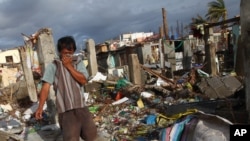CEBU CITY, PHILIPPINES —
The Philippines Saturday increased the official death toll from Typhoon Haiyan. It now says 3,633 are listed killed, but that number could rise significantly as rescuers reach more isolated island communities hit by the November 8 storm. Also not clear is just how many people are missing.
The government tally shows 1,179 people missing. However, the Philippines Red Cross says it has received 25,000 “tracing requests.”
A spokesman for President Benigno Aquino says the official tallies of dead, injured and missing rely on numbers fed from local governments to provinces and then on to the national authorities.
The Red Cross secretary-general in Manila, Gwendolyn Pang, says her organization’s higher figure includes all those believed lost, missing or otherwise not reachable, and likely has duplicate entries.
President Aquino, who has faced criticism for a perceived delayed and ineffective response to the disaster caused by one of the strongest ever recorded storms on the planet, is to visit Tacloban, in Leyte province, Sunday.
Tacloban is where more people are believed to have died than any other location. But more than a week after Typhoon Haiyan, information is still sketchy from some locations, especially smaller islands.
Philippines Congressman Ben Evardone, after an aerial survey of his district, exclaimed “there is no more Eastern Samar province.” Eighty percent of his constituents rely on coconuts for their livelihood and all of the trees have been uprooted or are gone. Evardone says it will take five to 10 years to replant and he has no idea how the people there will earn money in the meantime.
In one city, Daanbantayan at the northern tip of Cebu, which was directly in the path of the typhoon, officials say 100 percent of agriculture was destroyed.
At an ad hoc aid station there, resident Josefa Taneo, predicts the area’s recovery will not be easy.
“The livelihood of the people here is limited to fishing and small farming so we are not expecting to rebuild this soon," said Taneo. "Maybe this will take time because most of the small house are blown down.”
While some residents are already trying to rebuild their homes in Cebu and Leyte provinces, bodies remain uncollected in some of the worst-hit area in Leyte.
Officials in both provinces acknowledge increasing numbers of people ill from lack of proper nutrition.
As for finding out who is dead or alive, Red Cross Secretary-General Pang tells VOA volunteers are being mobilized for all areas and, likely, beginning Tuesday, they will begin registering survivors.
That effort could be complicated and take significant time, much to the dismay of relatives in other cities and countries anxious for word about the fate of loved ones. U.N. agencies say nearly three million people have been displaced by the disaster and hundreds of thousands of them are on the move.
The government tally shows 1,179 people missing. However, the Philippines Red Cross says it has received 25,000 “tracing requests.”
A spokesman for President Benigno Aquino says the official tallies of dead, injured and missing rely on numbers fed from local governments to provinces and then on to the national authorities.
The Red Cross secretary-general in Manila, Gwendolyn Pang, says her organization’s higher figure includes all those believed lost, missing or otherwise not reachable, and likely has duplicate entries.
President Aquino, who has faced criticism for a perceived delayed and ineffective response to the disaster caused by one of the strongest ever recorded storms on the planet, is to visit Tacloban, in Leyte province, Sunday.
Tacloban is where more people are believed to have died than any other location. But more than a week after Typhoon Haiyan, information is still sketchy from some locations, especially smaller islands.
Philippines Congressman Ben Evardone, after an aerial survey of his district, exclaimed “there is no more Eastern Samar province.” Eighty percent of his constituents rely on coconuts for their livelihood and all of the trees have been uprooted or are gone. Evardone says it will take five to 10 years to replant and he has no idea how the people there will earn money in the meantime.
In one city, Daanbantayan at the northern tip of Cebu, which was directly in the path of the typhoon, officials say 100 percent of agriculture was destroyed.
At an ad hoc aid station there, resident Josefa Taneo, predicts the area’s recovery will not be easy.
“The livelihood of the people here is limited to fishing and small farming so we are not expecting to rebuild this soon," said Taneo. "Maybe this will take time because most of the small house are blown down.”
While some residents are already trying to rebuild their homes in Cebu and Leyte provinces, bodies remain uncollected in some of the worst-hit area in Leyte.
Officials in both provinces acknowledge increasing numbers of people ill from lack of proper nutrition.
As for finding out who is dead or alive, Red Cross Secretary-General Pang tells VOA volunteers are being mobilized for all areas and, likely, beginning Tuesday, they will begin registering survivors.
That effort could be complicated and take significant time, much to the dismay of relatives in other cities and countries anxious for word about the fate of loved ones. U.N. agencies say nearly three million people have been displaced by the disaster and hundreds of thousands of them are on the move.












